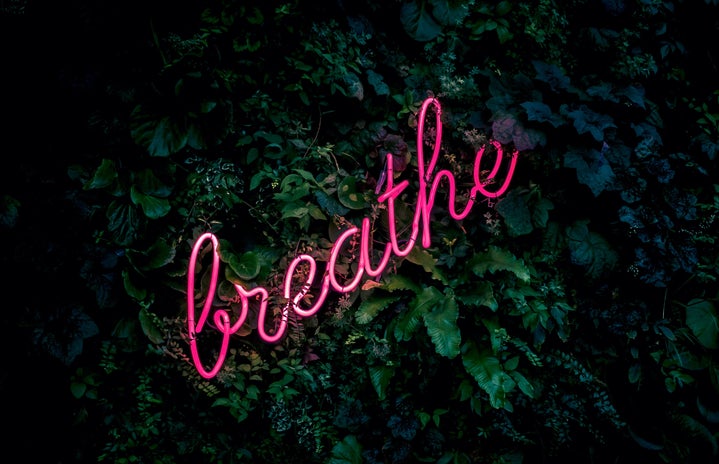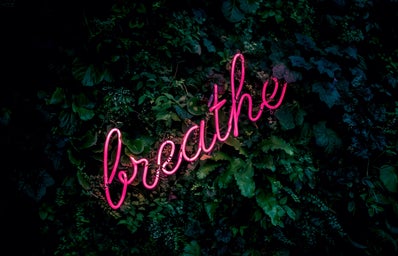When I was a senior in high school, we did yoga in gym class every Friday. I remember being challenged with the movements but feeling great afterwards. We spent the final 10 minutes meditating every time, and I would go to my next class feeling so refreshed. Needless to say, after our first class, I was hooked! Since then, I always envisioned myself as someone who does yoga regularly, and I joked that I wanted to be a yoga mom someday, but I never practiced outside of PE.
Fast forward to January 2020, my mom shared Yoga with Adrienne on my Facebook page. For those of you who don’t know, Adrienne is a yoga instructor on YouTube. She often does 30 day challenges, and my mom thought I would be interested. I went to Five Below and bought my first yoga mat that same day.
I started Adrienne’s 30 day challenge the next day, and I think I kept up for close to two weeks. The excitement started to wear off, and I realized daily sessions probably weren’t great for me personally. But I kept practicing at least 3 times a week, and I still do.
One of the best things I have gained from yoga is the ability to meditate. I love to meditate whenever I’m in a funk because it helps me gain focus. I meditate after each yoga session for at least 2 minutes because it’s great to let the body digest all of those challenging movements. Between settling nerves and simply making me happier all around, meditation has helped me in so many ways. I truly think anyone can benefit from meditation and encourage everyone to give it a try. With that being said, meditation takes a lot of practice and I know I was easily discouraged when I first started.
Here are my tips for meditation in case you need a serious brain break or boost of positivity and relaxation this week.
Find a position that works for you – I love to meditation lying on my back with my palms facing up. This is a great position to start with because I think it offers optimal comfort. However, you can also rest your hands on your stomach or the mat, or even try sitting up with your legs crossed. Meditation can be done absolutely anywhere and at any time! Don’t be afraid to try a bunch of different positions or use a chair, bed, or couch if you want!
Start small – You can start by doing 2-5 minute meditations throughout your day or just every other day. The more you do it the better you get, I promise!
Meet yourself where you are – Meditation feels different for everyone and sometimes it doesn’t go as planned. It’s totally okay if one day meditating feels great and the next you just can’t get there. Meditation is not about the absence of thought, but the acceptance and release of thoughts. When you feel like you can’t relax, don’t be hard on yourself. If thoughts keep popping into your head, take it as a sign that something within you needs attention. When meditating, we should try to process what arises and dismiss thoughts when we’re ready to. Meditation offers clarity that is hard to find elsewhere, so don’t be worried if it feels like you’re “thinking too much.” Sometimes I have entire sessions where my brain never slows down, but in the end I still feel refreshed and glad I took the time to lay down and not do anything but think and breathe.
Use guides – There are so many great YouTube challenges dedicated to yoga and meditation, and finding an instructor that gets you in the zone can be a game changer. It can be super helpful to have someone there reminding you what to do and keeping you on track when you’re just beginning. If you find videos don’t work, consider trying music, ambient noise, or podcasts.
Focus on your breath – Always begin by finding a deep, slow, rhythmic breath. This can look like inhaling for 5, holding for 2, and exhaling for 6, or a similar technique. Or simply just taking a moment to inhale a little deeper. It helps a lot to change your breath, because it literally alters what is happening inside your body! You can also use your breath to ground yourself by returning to a specific pattern or simply focusing on how your breath feels whenever you feel distracted. Breathing is the perfect thing to focus on during meditation because it’s natural and typically unemotional.
Find your happy place – This is a technique we used in gym class a lot. Once you’ve established your breath, start to imagine your happy place. I often find myself in a hammock by the lake, on a beach, or snuggled in bed with coffee and a book on a Saturday morning. Whenever you are sending your brain to your happy place, try to incorporate all of your senses. Can you feel the sun on your skin? Can you smell fresh-baked cookies? Are there birds chirping? This is a super fun and relaxing way to take yourself out of whatever situation you are currently in.
Focus on a mantra – Remind yourself of one word or saying that you want to embody. This can be an intention for the day, a favorite quote, or just something you hope to feel. For example, I find myself using strong, capable, prepared, happy, and at peace often. Your word can be anything at all—it is just super helpful to have an intention or positive feeling to return to throughout your practice. It really helps you feel in the zone and control of your mind, body, and the events of your day.
Tension and Release – This is a technique that I found very helpful when I started. I’m not sure if there is a more technical name for it, but basically what you do is squeeze your muscles and tense up your whole body and then release to feel intense relaxation. Usually, you start by squeezing your right fist for 3 seconds and releasing. Then, you tense your entire right arm and release. You repeat for both arms and legs and then your eyes, jaw, forehead, and entire face. Each release feels like energy is physically leaving your body. I can feel my body slowly relaxing and sinking into the earth piece by piece. Of course, this is super relieving when you’re feeling stressed, but it is also a great way to ease your body into deep relaxation over time.
Come back slowly – When you’re reaching the end of your meditation, always allow your breath to return to its regular rhythm for at least 30 seconds. Usually my breath goes back to normal naturally unless I am specifically using it to ground myself, so you may not need to consciously return. But, if you are still focusing on deep breaths, make sure you take a few normal breaths before you open your eyes (if they were closed). The end of your meditation is crucial! Wiggle your fingers and toes to slowly ease your body and mind back to earth. Blink your eyes open slowly and don’t try to sit up too fast. Coming out of a meditative state too quickly can sacrifice all of the relaxation you created or even cause a head-rush. It’s important to be gentle and allow yourself the time to get back into your daily routine.



